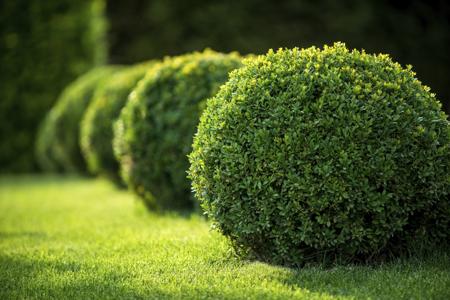A very popular choice for planting hedges, Japanese boxwood shrubs grow up to 2 meters tall, and are mostly used as ornamental plants. These native trees of Japan and Taiwan require a lot of care for growing in gardens or along pavements.

Smelly Wood
The scent of Japanese boxwood plants is perceived differently by different people. Some think that it smells like cat urine, while others say that the scent resembles a musky odor, or even like the plant product called resin. Some people have also described the smell to be pleasant.Japanese boxwood
(Buxus microphylla) shrubs are also called little-leaf boxwood, and are generally sub-divided into two varieties-japonica and
tarokoensis, originating from Japan and Taiwan, respectively. These floral varieties have a slow growth rate (about 3 inches per year), which often depends on the amount of sunlight and nutrition received. If pruning is not done, these plants can spread up to 4 feet in width. Along with their use as a hedge, boxwood plants can be used as natural fences, plant-based landscape elements, and to impart evenness to a plantation area.
Buxus microphylla can also be used as topiary trees for depicting any architectural or animal-based forms (a floral species cut in such a manner to appear as a different entity, like a sculpture, a human form, or an animal). It is classified as being suitable under Plant Hardiness Zones of 6 to 9, as given by the U.S. Department of Agriculture. This shrub matures in about 4 years, and is characterized by small, oval leaves which grow up to an average length of 20 mm. The blossoms are white-colored, which mainly bloom during the spring season.


Steps to Follow While Planting Japanese BoxwoodThis plant grows best in places that receive a moderate amount of sunlight, along with ample shade. The sections below will tell you about the various ways by which you can plant, as well as take care of this floral species.

Select the plant saplings from a nearby nursery, and ensure that they are kept in earthen containers or pots, and avoid those kept in plastic bags; the quality of the latter might be a bit low, as plastic slowly reacts with water which is present in the soil-filled bags.

Prepare the space needed to plant this shrub and use well-drained soil with abundant moisture. The area should be chosen in such a manner that it is neither near any constructed structures or buildings, nor entirely situated in an open space.

Make a pit in the soil that corresponds to the depth of the sapling's roots, and is wide enough for it to grow laterally. Before planting, make sure that you remove any diseased leaves or roots, which might cause a problem later on (like infestation of pests).

Gently lower the plant into the pit, and maintain a similar height that was present before its removal. Slowly fill the soil around the stem in a spiral manner, and remove all the air pockets before completely leveling the surface. Wait for a few weeks for the plant to grow substantially before trimming and shaping it.

Taking Care of the Japanese Boxwood

As far as possible, use alkaline soil for providing enough nutrition to this tree. Some species also grow well in slightly-acidic soil types, along with an addition of peat moss, or any other compost or manure, preferably during the spring season.

The supply of water should always be maintained, and ensure that you do not over-water the plant; this would probably cause its death. The soil should always be kept moist even though the shrub is drought-resistant. Add inorganic fertilizers, preferably in the fall season.

Pest control should be regularly done, as these plants are quite susceptible to infections from leaf-miners, mites, and other aphids. Timely spraying of insecticides and pesticides is mandatory to solve such problems. Contact an expert if infestation is very serious.

As far as possible, use fertilizers and soil amendments, as these would be beneficial in increasing plant growth. Follow the instructions carefully about using such chemicals, as any product utilized in the wrong proportions or manner will stunt the growth of the plant.

Regular pruning is absolutely essential in order to reduce the chances of pest infestations, and avoid pruning at least six weeks before the winter. Boxwood psyllids, two spotted spider mites, phytophthora root rot, and nematodes are few examples of pests that commonly affect this tree.In the winter season, Japanese boxwood shrubs might get affected by snow, hail, and sleet, and hence, it is necessary to protect them by constructing fences along with protective screens around and above them. If any part becomes damaged during such a time, it is necessary to prune it immediately.

WarningThe Japanese boxwood is extremely poisonous and should not be consumed under any circumstances. The leaves are especially toxic as they contain steroidal alkaloids. Small children and animals should be kept away from these plants, as their contact might induce skin rashes and dermatitis. The alkaloids may also cause vomiting and dizziness. Gardeners should always wear protective gear such as gloves and full-sleeved clothes, in order to reduce the chances of contact while trimming or pruning the plant.The Japanese boxwood appears beautiful when pruned and trimmed down to various shapes and sizes. Always remember to trim at least one-third of old boxwood plants during pruning. Also, decreasing the density in the middle portions will help in the penetration of sunlight, thus promoting the shrub's growth. Apart from pavements and gardens, this shrub is also used for plantation along decks, patios, porches, walkways, etc.






 Smelly WoodThe scent of Japanese boxwood plants is perceived differently by different people. Some think that it smells like cat urine, while others say that the scent resembles a musky odor, or even like the plant product called resin. Some people have also described the smell to be pleasant.Japanese boxwood (Buxus microphylla) shrubs are also called little-leaf boxwood, and are generally sub-divided into two varieties-japonica and tarokoensis, originating from Japan and Taiwan, respectively. These floral varieties have a slow growth rate (about 3 inches per year), which often depends on the amount of sunlight and nutrition received. If pruning is not done, these plants can spread up to 4 feet in width. Along with their use as a hedge, boxwood plants can be used as natural fences, plant-based landscape elements, and to impart evenness to a plantation area.
Smelly WoodThe scent of Japanese boxwood plants is perceived differently by different people. Some think that it smells like cat urine, while others say that the scent resembles a musky odor, or even like the plant product called resin. Some people have also described the smell to be pleasant.Japanese boxwood (Buxus microphylla) shrubs are also called little-leaf boxwood, and are generally sub-divided into two varieties-japonica and tarokoensis, originating from Japan and Taiwan, respectively. These floral varieties have a slow growth rate (about 3 inches per year), which often depends on the amount of sunlight and nutrition received. If pruning is not done, these plants can spread up to 4 feet in width. Along with their use as a hedge, boxwood plants can be used as natural fences, plant-based landscape elements, and to impart evenness to a plantation area.
 Steps to Follow While Planting Japanese BoxwoodThis plant grows best in places that receive a moderate amount of sunlight, along with ample shade. The sections below will tell you about the various ways by which you can plant, as well as take care of this floral species.
Steps to Follow While Planting Japanese BoxwoodThis plant grows best in places that receive a moderate amount of sunlight, along with ample shade. The sections below will tell you about the various ways by which you can plant, as well as take care of this floral species. Taking Care of the Japanese Boxwood
Taking Care of the Japanese Boxwood WarningThe Japanese boxwood is extremely poisonous and should not be consumed under any circumstances. The leaves are especially toxic as they contain steroidal alkaloids. Small children and animals should be kept away from these plants, as their contact might induce skin rashes and dermatitis. The alkaloids may also cause vomiting and dizziness. Gardeners should always wear protective gear such as gloves and full-sleeved clothes, in order to reduce the chances of contact while trimming or pruning the plant.The Japanese boxwood appears beautiful when pruned and trimmed down to various shapes and sizes. Always remember to trim at least one-third of old boxwood plants during pruning. Also, decreasing the density in the middle portions will help in the penetration of sunlight, thus promoting the shrub's growth. Apart from pavements and gardens, this shrub is also used for plantation along decks, patios, porches, walkways, etc.
WarningThe Japanese boxwood is extremely poisonous and should not be consumed under any circumstances. The leaves are especially toxic as they contain steroidal alkaloids. Small children and animals should be kept away from these plants, as their contact might induce skin rashes and dermatitis. The alkaloids may also cause vomiting and dizziness. Gardeners should always wear protective gear such as gloves and full-sleeved clothes, in order to reduce the chances of contact while trimming or pruning the plant.The Japanese boxwood appears beautiful when pruned and trimmed down to various shapes and sizes. Always remember to trim at least one-third of old boxwood plants during pruning. Also, decreasing the density in the middle portions will help in the penetration of sunlight, thus promoting the shrub's growth. Apart from pavements and gardens, this shrub is also used for plantation along decks, patios, porches, walkways, etc.